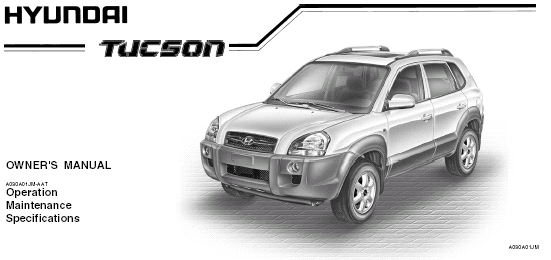Hyundai Tucson Owner's manual

WARRANTIES FOR YOUR HYUNDAI VEHICLE
Please consult your Owner's Handbook & Warranty Information booklet for
your vehicle's specific
warranty coverage.
RESPONSIBILITY FOR MAINTENANCE
The maintenance requirements for your new Hyundai are found in Section 5. As the owner, it is your responsibility to see that all maintenance operations specified by the manufacturer are carried out at the appropriate intervals.
When the vehicle is used in severe driving conditions, more frequent maintenance is required for some operations.
Maintenance requirements for severe operating conditions are also included in Section 5.
All information in this Owner's Manual is current at the time of publication. However, Hyundai reserves the right to make changes at any time so that our policy of continual product improvement may be carried out.
This manual applies to all Hyundai 
models and includes descriptions and explanations of optional as well as
standard
equipment. As a result, you may find material in this manual that does not apply
to your specific vehicle.
CAUTION: MODIFICATIONS TO YOUR HYUNDAI
Your Hyundai should not be modified in any way. Such modifications may adversely affect the performance, safety or durability of your Hyundai and may, in addition, violate conditions of the limited warranties covering the vehicle.
Certain modifications may also be in violation of regulations established by the U.S. Department of Transportation and other federal or state agencies.
TWO-WAY RADIO OR CELLULAR TELEPHONE INSTALLATION
Your vehicle is equipped with electronic fuel injection and other electronic components. It is possible for an improperly installed/adjusted two-way radio or cellular telephone to adversely affect electronic systems. For this reason, we recommend that you carefully follow the radio manufacturer's instructions or consult your Hyundai dealer for precautionary measures or special instructions if you choose to install one of these devices.
SAFETY AND VEHICLE DAMAGE WARNING
This manual includes information titled as WARNING, CAUTION and NOTE.
These titles indicate the following:
WARNING:
This indicates that a condition may result in harm, serious injury or death to
you or other persons if
the warning is not heeded. Follow the advice provided with the warning.
CAUTION:
This indicates that a condition may result in damage to your vehicle or its
equipment if the caution is
not heeded. Follow the advice provided with the caution.
NOTE:
This indicates that interesting or helpful information is being provided.
VEHICLE DATA COLLECTION AND EVENT DATA RECORDERS
Your Hyundai vehicle is equipped with many high technology, electronically
controlled systems that
help to ensure your vehicle operates properly and provides the performance that
you expect. These
systems utilize computers to monitor the operation of various systems and
components and help to
control their operation. These computerized system operations are wide-ranging
and involve
components to reduce emissions, to continuously evaluate the readiness of the
airbag and seat belt
pretensioner systems, to determine when the airbag and seat belt pre-tensioner
systems should be
deployed and then to activate the deployment, and if equipped, to operate
anti-lock braking, traction
control and electrical stability control to assist the driver to control the
vehicle in difficult driving
situations. These systems electronically store information that is useful to
service technicians when
they need to diagnose and repair these systems. Additional information is stored
only when a crash
occurs that results in the deployment of the airbags or seat belt
pre-tensioners. This type of data storage
is done by devices called event data recorders(EDR).
After a crash event, the airbag and seat belt pre-tensioner computer system,
known as the Supplemental
Restraint System Control Module (SRSCM) or Airbag Control Unit (ACU), may record
some information
about the condition of the vehicle and how it was being operated. This
information consists of data
related to seat belt usage and if there was diagnostic information in the airbag
or seat belt systems
at the time that a crash occurred, and if the ACU sensed that a crash of
sufficient severity occurred to
require seat belt pre-tensioner or airbag deployment.
To retrieve this information, special equipment is needed and access to the
vehicle or the device that
stores the data is required. Hyundai will not access information about a crash
event or share it with
others except:
o in response to an official request of police or similar government office, or.
o with the consent of the vehicle owner or, if the vehicle is leased, with the consent of the lessee, or.
o as part of Hyundai’s defense of litigation, or.
o as required by law.
See also:
To Clean the Vinyl Upholstery
To clean the vinyl upholstery, first remove loose dirt and dust with a vacuum
cleaner. Then apply a solution of mild soap or detergent and water using a clean
sponge or soft cloth. Allow this to s ...
Styling
The redesigned Elantra makes a good case for being the most stylish new
compact sedan on the market. The car's designer, Cedric D'Andre, said one of the
goals of the design was to create a car tha ...
WORLD CLASS POWER-TO-WEIGHT RATIO
One of the program targets for the 2011 Sonata engineering team was
world-class power-to-weight ratio. Power-to-weight ratio pays dividends in both
performance and fuel economy.
Hyundai Sonata i ...


